
A harrying gust of icy raindrops blows along the crest of England’s South Downs as blades of distant sunshine shift and spotlight the town below. It is late October and the afternoon has assumed a burden, almost a petulant sulk. With my eyes stinging, screwed up, squinted tight against a shower of tiny needles, I look for an easier path and head for the coastal strip of suburb below, leaving the high down behind.
I chat with Dad on the way down. I like to keep him up to date with things, the grandchildren he has never met, the wife he knew as my girlfriend and the delights of our new home. I talk of our shared love of London and I hear him say ‘it’s a young man’s game’, which I guess means it isn’t suitable for either of us. I gabble about all the latest technologies and cover a catalogue of the world’s change in a handful of short years. I play him the sampler of Japanese jazz I downloaded from iTunes and an old Mr Scruff remix of a Ramsey Lewis favourite, pausing only to explain what downloading and iTunes are once again. He used to be quite the technologist in the magnetic tape age, but digital is lost on him, he never grasped the idea and, in any case, he doesn’t hear a word of this. He’s not actually with me and, having died 23 years ago, that’s probably for the best.

I am alone in this conversation – still a desperate grasp for the essence of him – as I walk down a gargantuan, gently buckled slab of soft white rock. Forty thousand cubic miles in volume and a mile thick, from here it stretches to the edge of the west country and north to Yorkshire, south and east across the Channel and the North Sea to northern France, the Low Countries and beyond. The scale of it dwarfs everything that touches it, but its size is only part of the story.
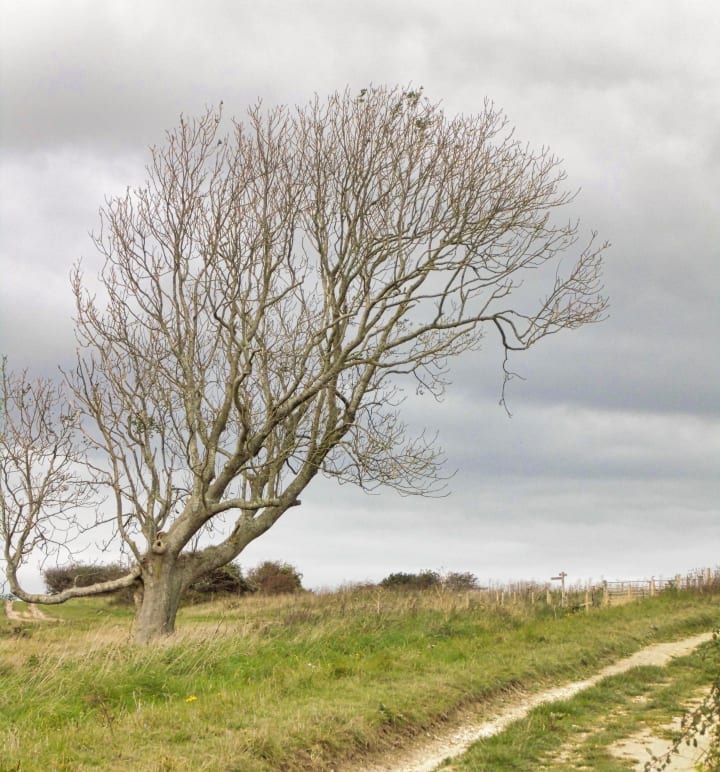
Like persistent grief or some other unresolved anguish, the weight of the rock can be sensed without really seeing the complete article. There is a feeling of density, an awareness of its snow-white, ethereal form, a form that can be held in the mind, rotated in its conceptual dimensions, yet never reveal itself whole. No matter which way you turn it, a side is always hidden in the lee of your gaze. It’s the bit that evades resolution, the part that shelters from attention, the face concealed that would finally make grasping a sense of its whole form possible. The rock is heavy too, overfull, carrying its own burden, saturated, leaking from the edges at the springs where its base meets the impermeable clay. Raindrops that fell ten days, ten months, ten years or more ago, pool and trickle into clear, fresh streams at its feet.
I’m here on my own private percolation, letting the memories drip through the semi-permeable membrane that seems to keep me from my past. It is an effort to reclaim the landscape of my formative years.
Large tracts of my childhood were spent hovering at the junction of self-awareness and unconsciousness, a semi mesmeric state induced by Phenergan, the 1970s asthmatic’s anti-histamine du jour. In some parts of the world it is a medicine considered so potent it is still prescribed for insomnia, a strong-arm sedative that acts as a cheap alternative to luxury benzodiazepines like Valium. It is no mystery why trying to remember the specific events of my early years is so difficult. I’m hoping that, like all coma victims, a familiar scent, sight or sound will re-awaken something.
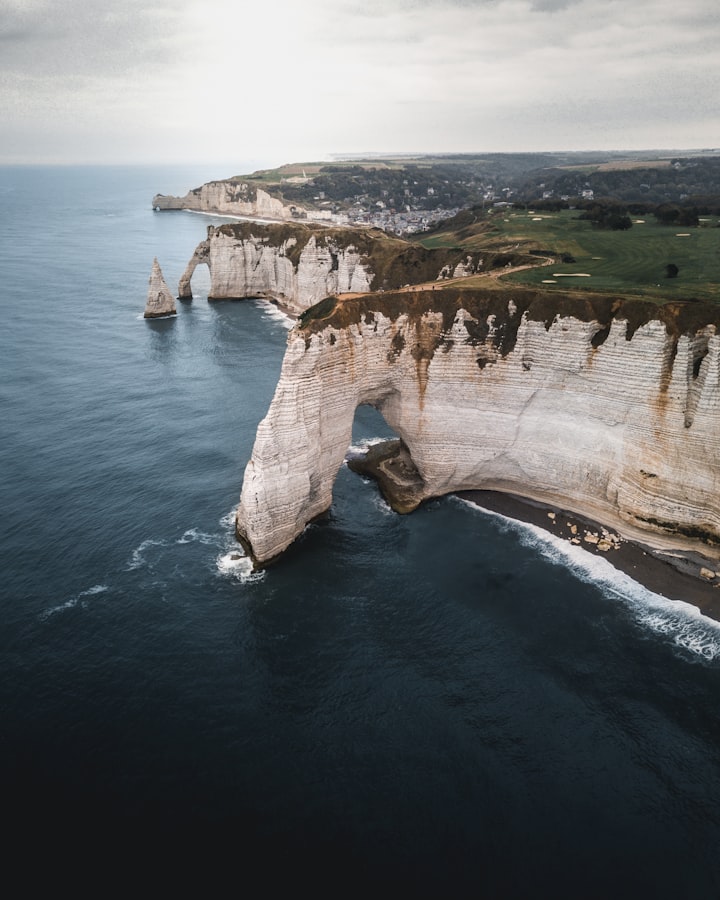
The rock was thirty five million years in the making, a span of time that offers perspective on our own short lives, yet it is made from countless microscopic shells, the tests of single-celled plankton whose lives were measured in days. One hundred million years ago, immeasurable blooms of these tiny creatures photosynthesised in hot-tub oceans, their shells falling to the sea floor in perpetual blizzards of marine snow, creating a glutinous ooze that would eventually drift and petrify into its current form.
On the downs, thin soils now cover the rock and, over those soils, a soft sward with shallow roots. This is home turf to me and I can’t resist the notion that, like the grass, my roots are rather superficial, barely clinging on to the substance of what geologists like to call the country rock.
‘Home’ was eighteen different places in as many years – houses, flats, caravans, wooden chalets – in seven different counties, so my concept of belonging to a place, to feel a connection with some spot on the planet’s surface, is rather shaky at best. The locations I lived in until I left the family home just have to serve as placeholders, book marks in my story. Often only spending a matter of months in a place, wherever we lived it always felt like an intrusion, an injection of ourselves into the surrounding strata.
We moved around because of money. Wherever we went, we were the victims of a very local circumstance, wind-blown at the behest of an economic microclimate that attached itself to my father. Travelling from place to place, my brother and I from school to school, caught in Dad’s financial woes, one moonlit flit to the next. It wasn’t easy for him; every day he started with money to put petrol in the car and French cigarettes in his mouth and every evening he returned with little more but the same again and some groceries from Fine Fare. His life, like plankton, was played out in days.

For many years, the journey from place to place seemed to describe the outcrops that formed the downs of southern England. Our path west from Sussex to East Devon, to Somerset, then East Anglia became an unknowing homage to a geological formation. It was finally broken by escape from the planet altogether in the shape of a long, out-of-character stay in West Cornwall. I made that journey when I was 19.
After I had left home, my parents exacted a reprisal and moved into my Lowestoft flat with me for several months, where they overplayed their hand eating too much of my cheese and needlessly criticising my furniture. Reprisal turned to reprise as my father sold me the idea of a semi-tropical paradise in Cornwall and bundled me and my stuff into a beaten up Morris Marina for a trek to England’s far west from Britain’s furthest east. It felt like a particularly long-form act of kidnapping at the time and followed the downs for most of the way, slingshotting London and taking the M4 then the A303 southwest to the semi-tropical paradise. There was a foot of snow on the ground when we arrived.
The line from Lowestoft to Lands End even has an ancient route associated with it, carrying Britain’s oldest track, the Icknield Way, while New Agers insist it also demonstrates an alignment of significant ancient artefacts along what they refer to as the St Michael Ley Line. Among these artefacts, strung out like pearls across the south of England, they say, is a high count of churches with St Michael or St George dedications, all found in positions on raised ground. Whether this is coincidence or not might be illuminated by research from the 1980s that made similarly impressive claims for alignments of former branches of Woolworths. What, perhaps, it does show is that the density of artefacts on the downs is high enough for such coincidence to occur and that leads one to wonder whether, as the crucible of Bronze Age civilisation in Britain, the downs must take their place in our national identity as much as they do in my personal identity.
High, steep cliffs assume a dominant profile by a sea that continually undermines them
Certainly, sixty-five million years or so after the principal rock of the downs was formed, it became burdened with its own iconography as well as a few contradictions – a symbol of British, particularly English, national identity and a bulwark against invasion, it forms high, steep cliffs that assume a dominant profile by a sea that continually undermines them, keeping them keen, accentuating their commanding height through their continual submission.
The rock presents itself in varying degrees of softness, is permeable and soluble in rain but contains within its beds layers of flints - one of hardest rocks known. It is the source of 70% of the UK’s groundwater as well as the fount of cold, clean, sweet tasting springs which accumulate into clear streams where kingfishers perch and trout swim. In Southern England, the habitat seems common, but is one of rarest combinations of geology and climate anywhere in the world, making it a uniquely English idyll. This little paradise is where I come from, the landscape of my youth, it is made of chalk and, identifying with the landscape as I do maybe I am, in a sense, made of chalk as well.
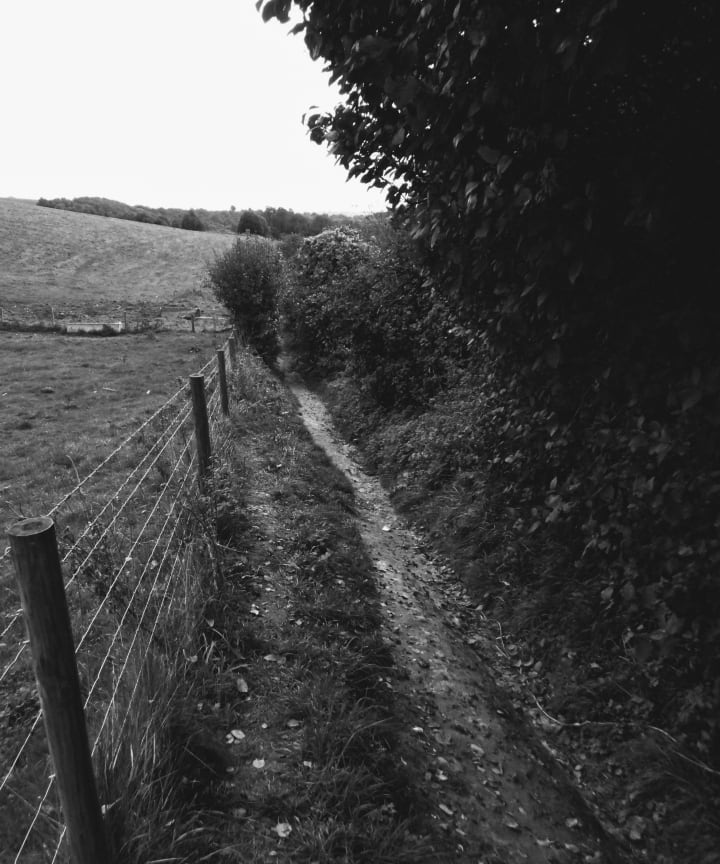
The dip slope that leads south from Cissbury Ring, the largest hill fort in Sussex and crown of its own escarpment, is almost as steep as the scarp that drops away to the north. In autumn, it becomes just as hazardous. The path narrows into its own stream-cut gully, a surface of marly, glutinous chalk which recalls its origins on the bed of a shallow primeval ocean. As good as polished by a veneer of algae and lubricated by the rain, my descent down the path is a series tip toe straddles – an ice ballet for the ample man. My father abandons me for the descent; much as he liked to hold forth on his romantic plans to walk the coast path, he was never rambling material.
The path lies in the fold of a crease between two monocultures. To one side, the slope is denuded of character; evened and landscaped into the lawns and pristine hummocks of a golf course, like some virtual world of textured polygons, stripped of unnecessary detail and unauthorised organic matter. A parade of hawthorn keep out the public but, of course, who would want to break into a golf course?
On the other side of the path, the hill assumes the contours of a scarp, ribbed with catsteps or – depending on your upbringing, sheep tracks – the outcome of a cumulative cycle of soil soaked and dried over thousands of years on the porous chalk. These terracettes, tightly-packed like the isobars of a winter storm, are only one mark among many that hint of a deep history on the downs.
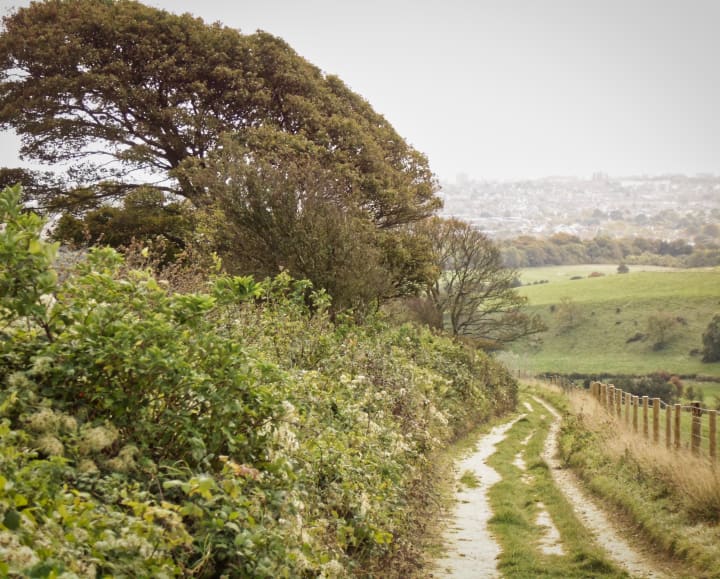
My history is not as clear as the marks that time has left on the ground. Blurred both by dislocation and strong anti-histamines, the intervening years have left me with a longing to understand ‘place’ as part of a simultaneous search for belonging; a deep need to understand whatever it is that is missing.
Twenty years in Cornwall taught me that, for all its wild, outlaw charisma, its Atlantic gales and mizzle are not part of any habitat I would recognise as my own. I probably stayed for the novelty of not moving, of feeling settled but eventually my wife and I left for London and I started to make my way home, if only I could find it.
Ten years later with children of my own, I started to understand family and, not having anyone left to ask I started that search at the beginning, my beginning; up on the down, around the South Downs, the verdant, occasionally wild, playground of my youth before our moonlit flits started in earnest, before we had to start fitting in all the time, when we still lived in a place where we appeared to belong. My memories of seventies summers at Salvington Mill framed by a child’s eye view of bowed heads of golden wheat are mixed in with grainy black and whites of windy days with kites on Highdown Hill, but that’s all I have right now. I hope to find that sense of place quickly, to find a place that makes sense.
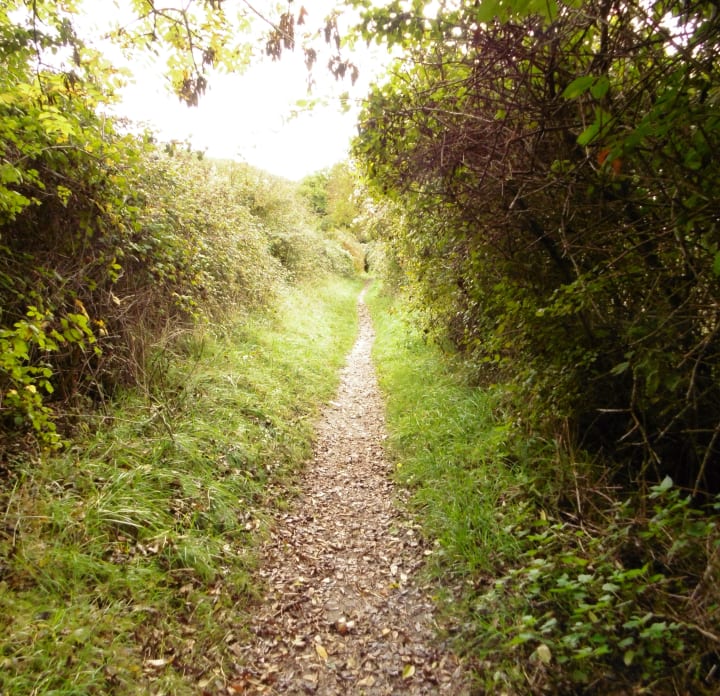
The path shakes off the character of the downs as trees cram in around it. Wild basil and harebell still flower in the lee of a stunted hawthorn, its crown cantilevered out like a quiff. Thicket and scrub tumble down the east side of the path, overwhelming it, the trees thicken and the path turns to tunnel. The chalk downs have always been more thinly vegetated than the dense forests of the clay vales. As a result, millennia of footfall along the ridges have made braided, ragged accumulations of interlocking lines on their slopes, each of them a centuries-old desire line twisted around the axis of a larger enterprise, to move from A to B in often less than ideal conditions.
When surveying these ancient routes, it’s not the relatively easier-going of the tops of the downs that provide the most interest, but the points of constriction, the bottle necks, the climbs up from the deep vales where a sunken green lane, a holloway is inscribed by the passage of thousands of feet, cartwheels and hooves over hundreds of years. With loosened soil subsequently washed away by the next downpour, the courses of thousands of unconnected endeavours become more pronounced. Travelling for any distance was difficult and the reasons were perhaps even more keenly felt; every footstep has meaning on a pilgrimage and the burdens shouldered on a well-used coffin road are more than the purely physical.
The suburbs grow nearer and the density of dog fruit and litter mark the various radii of half-arsed attempts to wander away from modern civilisation. The path passes an old holloway, at least 15 feet deep, where a rope swing has been improvised from an overhanging bough and where the scuff of trainers works a new desire line slowly into its bank. At the foot of the holloway, desire gives way to consumption. Covered in crisp wrappers and plastic drinks bottles, it’s a sobering treatise on what we do to our little paradises.

The last field on my left ends in a high, freshly creosoted fence. Behind it, amongst copper beech and ornamental shrubbery is a determinedly private residence if the plastic signs that carry the silhouettes of Alsatians and emphatic Helvetica warnings are anything to go by. High ground gives way to high-security - no alarm is apparently as shrill, no dog as fierce or barbed wire as pointed as their fear of what looms outside their bounds.
The afternoon’s sulk turns to almost twilight under the canopy of high beech and London plane and I am overwhelmed by a curious sensation. There is something tangible about the smell of the earth here, it is nothing but it is everything, like HV Morton’s ‘odour of Sanctuary’ that clings to a place; a genius loci, a presiding god lives here. I came here in search of place on the crest of a down and I suddenly find it in a suburban backwater just north of the A27. A word from the Welsh language – hiraeth - occurs to me; an all-consuming homesickness, a longing for a homeland almost too great to bear. I feel at home here, among the ludicrously expensive, half-timbered, 1950s detached villas of West Sussex. I am in the right place, for the first time in years. The revelation hits me like a train. Not only do I share something in common with strap-hanging Home Counties professional administrators and accountants, but as a nature writer, an ardent fan of wilderness and a lapsed ornithologist, I might have got my roots completely wrong. It appears that, at heart, I really belong here.
And then, I remember Highdown Hill again and that picture of the kite. I remember the more-or-less permanent blue-grey Gauloise haze I viewed my father through as absent on the crest of Highdown, the fumes of French cigarettes blown away by a full English breeze. The breeze is that odd mix of meadow air and sea salt that intermingles above the suburban strip of coastal plain.
The Downs and the sea eventually meet in the Deans and Havens east of Brighton on their way to the plunge of Beachy Head. Undulating waves and ripples of the hills eventually dominate the sea in high cliffs, but the command is short-lived; the sea continually undercuts the cliffs, makes a mockery of their picture-postcard resilience. Nature doesn’t need bluster, it only wants equilibrium and tranquility.
I remember the kite. Despite the breeze, the kite was untroubled by any kind of aerial movement whatsoever. A fact not lost on my father who, hunched against the wind and silhouetted against the silver sea, shouted instructions to his eldest, my brother, as frustration gained a foothold on him, undercutting, clambering up inside, to finally defeat him.

He was pathologically unsuited to flying a kite because it is a team game. Like the tango and its inspirations – passionate romance and bitter argument – flying a kite always takes two. A man in fleeting control is like the downs I walked and talked on my eventual arrival at the sea. Nature eventually defeated him as well in favour of tranquility and equilibrium. I think I may have found mine.
About the Creator
Ian Vince
Erstwhile non-fiction author, ghost & freelance writer for others, finally submitting work that floats my own boat, does my own thing. I'll deal with it if you can.






Comments
There are no comments for this story
Be the first to respond and start the conversation.